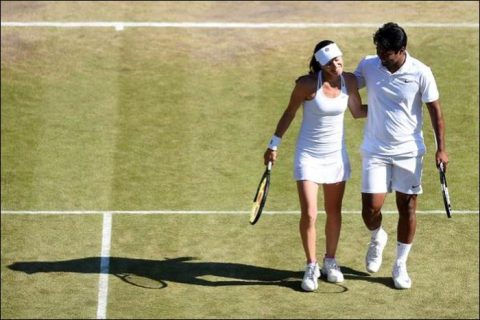Everything that I have said up to now about strokes, tactics, and so forth has had to do with playing singles. The singles game is the acme of tennis skill because it allows the widest range of attack and defence, strokes, tactics, and psychology, but the doubles and mixed doubles games have their own charm and fascination. Many people enjoy doubles more than singles, probably because they have to do less work, have a partner to blame for defeat and someone to listen to their gripes as they play.
It fills their social need far better than singles. The mixed doubles game, while a completely unbalanced and, in many ways, uninteresting game, still brings sex and beauty on the court-that is, if you’re lucky enough to have Gertrude Moran or someone like her, if there are any, as your partner.
Just why I should write of either doubles or mixed doubles will probably remain a mystery, since during my long career I successfully defended the title of “the world’s worst doubles player” over all comers throughout that time. The title was wished on me by Harold H. Hackett, a great doubles player of the past, who added the potent comment that I “parked my intelligence outside the stadium” because I dared to disagree with Mr. Hackett’s idea of how doubles should be played in a Davis Cup match against Australia.
The fact that R. N. Williams, II, and I won that Davis Cup doubles match, and that I won the United States Doubles Championship five times with three different partners, did nothing to change Mr. Hackett’s views or deprive me of my title. Personally, I disagree completely with Mr. Hackett’s valuation of my doubles, and, without fear, I am going to attempt to give an idea of the doubles and mixed doubles games.
Doubles and singles are quite different games in the manner in which you use the shots of tennis. Singles is essentially a baseline game, with occasional net attacks. Doubles is a net game, with as little back-court play as possible. Singles is a game of ground strokes; doubles is service, volley, and smash, with the ground stroke an added necessity in returning service. Singles is the game of moderation, average pace, with peaks of great power or subtle finesse. Doubles is a game of extremes. It is all terrific attack, or slow, delicate finesse, with practically no average-pace shots. This is largely because there are smaller openings on a doubles court; two men are covering very little more territory in doubles than one does in singles. So you must take greater chances to get shots past them.
In the old days, doubles found one team at the net with the other on the baseline, attempting to force them back and advance themselves. But they did not do so until they had forced the other team back. Today all four men are in at the net most of the time. The server’s partner naturally stands in, and the server naturally follows his service in.
That has been standard for years. Today the receiver’s partner stands in, and the receiver attempts to follow his service return to the net, thus bringing all four men to close quarters on practically every point. It certainly breeds brilliant, sensational tennis, which thrills the gallery, sets a tremendous pace, eliminates long rallies, and piles up amazing numbers of errors and some incredible placements.
But i wonder what would happen to this type of doubles against such great doubles teams of the past as William M. Johnston and C. J. Griffin, the Kinsey brothers, R. N. Williams, II, and Vincent Richards, George Lott and Lester Stoefen, Wilmer Allison and John Van Ryn, Ellsworth Vines and Keith Gledhill, Donald Budge and Gene Mako, to say nothing of such foreign pairs as Henri Cochet and Jacques Brugnon, Jean Borotra and Jacques Brugnon, Gottfried von Cramm and H. Henkel, F.J. Perry and G. P. Hughes,Jack Crawford and Harry Hopman, or Gerald Patterson and Norman E. Brookes. Somehow I feel that these teams of former days would have too much combined attack and defence for the modern game, and it would show up again that, even in doubles, the attack is overemphasized today.
Next Page: Doubles match and service battle.
